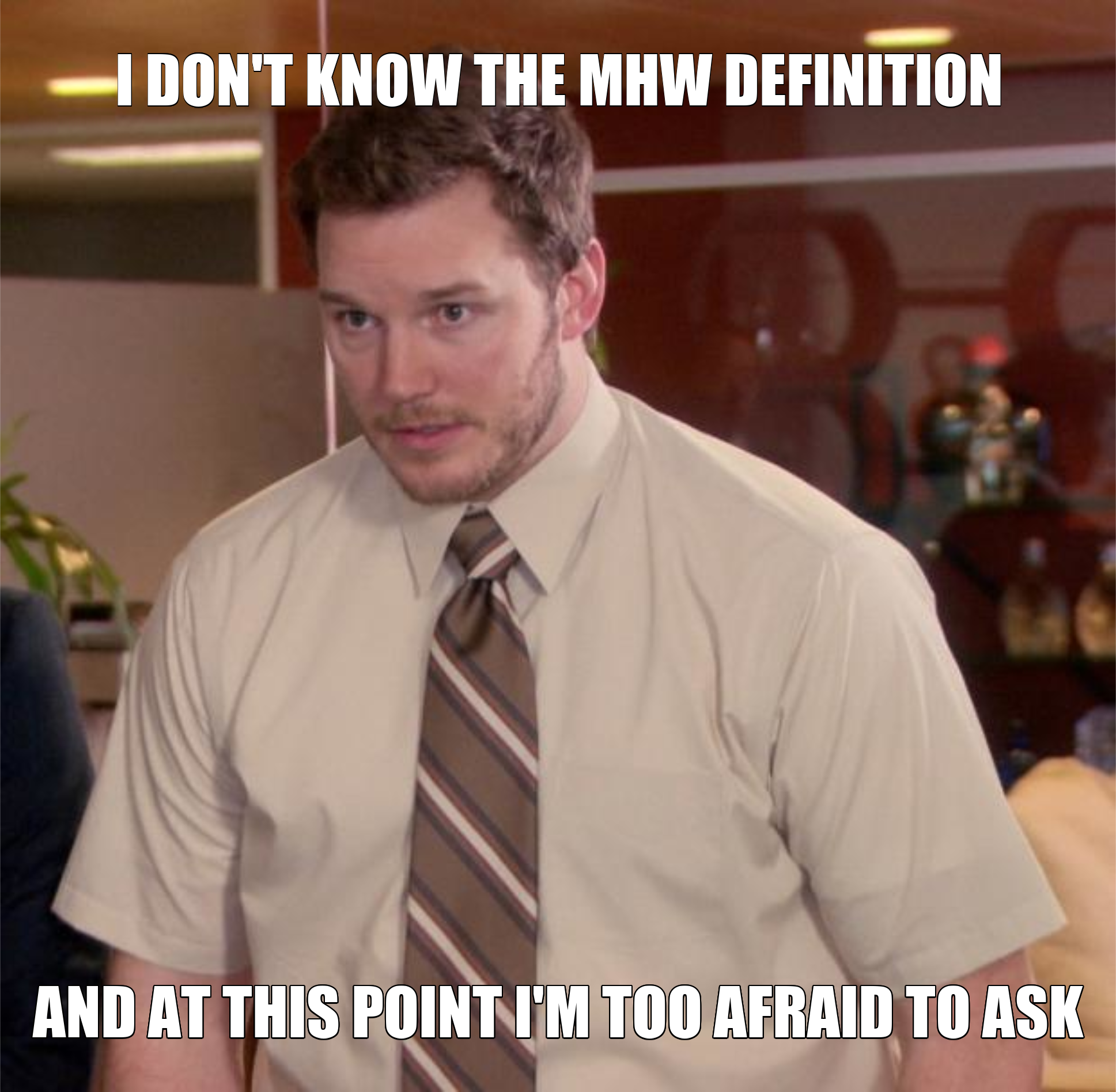
Welcome
This demo was designed to provide a visual and interactive explanation for how one may detect a marine heatwave (MHW) using the Hobday et al. (2016, 2018) definition. The demo is laid out via different navigation tabs at the top of the page. These represent the three overarching steps we follow to arrive at a MHW definition. On the left of this demo is a control panel. Each dropdown control menu is named according to the navigation tab that it will effect. We start by selecting one of three time series. Then we move on to see how different statistics (e.g. baselines and percentiles) affect climatologies and thresholds. Finally we decide how long a marine heatwave should be and detect all of the events in our time series that meet our criteria. The final panel 'The main event' showcases the results for the largest event detected in the time series. Please see the glossary below for the definitions of the values found throughout the legends in this demo.
NB: this demo is under active development. Please send any feedback to: robert.schlegel@imev-mer.fr
Click here for a
Glossary
temp : The temperature values (°C) of a given time series
mean : The overall mean value in a time series. Determined by averaging all daily data together to find a single value. This is used to determine the temperature anomalies in a time series, which may be used in place of the normal temperatures depending on a given investigation. Note that this is not standard.
trend : The linear trend present in a time series. One may use this value instead of the mean to create de-trended daily anomaly values for further MHW investigations. Note that this is not standard.
baseline : The period of time from which data are taken in order to calculate the seasonally varying climatology and threshold used in the detection of MHWs.
seas : The seasonally varying climatology (i.e. seasonal mean value). Typically this is calculated by taking all data within the baseline, grouping them by their day-of-year (DOY) and averaging+smoothing them with a rolling mean. The default rolling mean is a 5-day double-sided window (11 day total width), and the second smoothing pass is a 15-day double-sided window (31 day total width).
thresh : The seasonally varying threshold. using the data within the baseline, the 90th percentile (default) is applied to find the DOY value above which daily temperatures must exceed for a MHW to be detected.
min. duration : The minimum duration (days) that temperatures must consistently be above the threshold value before a MHW is detected.
max gap : Once a MHW has been detected, temperatures are allowed to dip below the threshold for this many days (default is 2) before a new event is detected. I.e. if an event is going for 7 days, then drops below the threshold for 2 days, but goes up again for 5 more days, this will be counted as a 14 day event. However, if that dip lasts for 3 days, it will be counted as two separate events.
MHW : An extreme event, a marine heatwave (MHW) is detected (by default) when daily temperatures are in exceedance of the 90th percentile threshold for 5+ days. There are many options that can be changed to alter the detection of events, as documented above.
focal MHW : When plotting one MHW in particular, it tends to be shown in red when other smaller events are also visible in the time series.
duration : The length of an MHW (days). Measured as the distance from the start date to the end date.
max. intensity : The maximum temperature anomaly (°C) detected during a given MHW. This is measured as the distance from the seasonal climatology to the observed temperature. Note, it is a common mistake to think that this value is measured from the threshold value to the observed temperaature. See the plot in 'The main event' tab for a visual explanation.
cum. intensity : The sum of all temperature anomalies during an event (°C x days). Note that the temperature anomalies are the distance from the seasonal climatology to the observed temperature.
I Moderate : The least intense category of MHW. If the max. intensity of an event is not more than double the distance from the seasonal climatology to the 90th percentile threshold, the event is classified as 'I moderate' For example, let's say that the seasonal climatology on the warmest day of a MHW happens to be 16°C, and the 90th percentile threshold is 18°C, this means that as long as the max. intensity is below 20°C it is considered to be simply a category 1 event (I Moderate). Generally speaking these have not been associated with impactful events in the literature.
II Strong : An event when the max. intensity is double, but not triple the distance from the seasonal climatology to the 90th percentile threshold. Using our example above, this would mean the max. intensity did not exceed 22°C. Events of this magnitude tend not to be associated with long-lasting ecological impacts, but when they occur during the spring or Autumn they can have significant impacts on the phenology of local species reproduction.
III Severe : The next step up. These events are often associated with mass mortality of local species.
IV Extreme : One final step higher. The (currently) highest category value. These events have been known to crash local ecosystems. Removing the established ecosystem in favour of a warmer neighbouring system. It is in this way that climate change is re-writing the ecology of coastlines more rapidly than projected.
Acknowledgement
The development of this application was supported by FACE-IT (The Future of Arctic Coastal Ecosystems – Identifying Transitions in Fjord Systems and Adjacent Coastal Areas). FACE-IT has received funding from the European Union’s Horizon 2020 research and innovation programme under grant agreement No 869154.


References
Hobday, A. J., Alexander, L. V., Perkins, S. E., Smale, D. A., Straub, S. C., Oliver, E. C., ... & Wernberg, T. (2016). A hierarchical approach to defining marine heatwaves. Progress in Oceanography, 141, 227-238.
Hobday, A. J., Oliver, E. C., Gupta, A. S., Benthuysen, J. A., Burrows, M. T., Donat, M. G., ... & Smale, D. A. (2018). Categorizing and naming marine heatwaves. Oceanography, 31(2), 162-173.